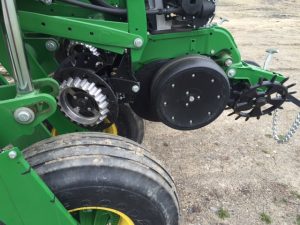No-Till Management Case Study: Stoneyvale Farm
Farmer(s): Bob and Travis Fogler
Location: Exeter, Maine
Farm Type: Dairy & Forage
Size: 1000 milking cows + 1350 acres of corn, alfalfa, and grasses
Soil Type: Mixture of Bangor, Thorndike, and Dixmont
Crops: Corn, alfalfa, potatoes
Cover Crops: Mixture of annual rye, winter rye, tillage radish, and crimson clover seeded after corn planting. Winter rye seeded post-harvest.
Weed Management: Mixture of cover cropping and chemical (Roundup and Verdict herbicides)
No-Till Management:
No-till since: Scaling up since 2008
Current equipment setup: Yetter row-cleaners, opening disks. Removed no-till coulters.
Advantages to using no-till management:
- Increased yields
- Reduced soil erosion
- Increased soil moisture and improved soil drainage
- Improvement in soil health and tilth
- Speed of getting corn planted, which allows for harvesting first crop of haylage when at peak quality
- Saving money on equipment, time, and fuel: estimated savings of $50 per acre of corn planted
Challenges to using no-till management:
- Planting windows can be narrow in wet conditions – on dewy mornings, row cleaners can cause mud to stick to plants and implements, and it is best to wait until the ground dries out later in the day to plant. Conversely, no-till fields themselves are markedly easier to work on when wet than conventional fields.
Advice to growers new to no-till:
- Be prepared to change your management style and planting schedule.
- Pay close attention to your planting implement, and understand that you may have to make frequent adjustments as you plant.
- Make sure your double disk openers are sharp and not worn, and your planter well maintained.
- Begin with a fall killed sod and always use cover crops.
- Start slowly! Try the system out on a small part of your farm, and expand gradually if and when you get positive results.
The Foglers and No-Till
Bob and Travis Fogler’s transition to no-till production started by accident. The Foglers, whose 1000 dairy cows are fed by forage crops grown on site, planted no-till corn for the first time into a field of fall-killed sod in 2008. Hoping simply to break up the sod in time for a fall planting, they planned to harrow in August what they were sure would be a failed corn crop. They were surprised and delighted when an outstanding crop of corn emerged, and were encouraged over time to transition nearly all of their 750+ acres of forage crop land to no-till management.
Rather than jump in all at once, the Foglers first experimented with no-till on their poorer soils: rocky sods that had not been worked in decades, and potato fields where the soil health was degraded from decades of production. (They share land with the Dorman family, who grow potatoes for chip stock). Their soil has responded well to the shift, becoming more resistant to erosion and less likely to dry out in the hottest part of the summer. Best of all, they’ve experienced increased yields while simultaneously saving money on tillage parts, time, and fuel. At this point, they are firm believers in the no-till system.
Cover Crops: Boost Yields and Control Weeds to Aid The Transition
The Foglers believe cover crops to be vital to the success of their no-till system, helping to control weeds, improve soil health, and build soil structure. Some growers experience a decrease in yield in their first several years using a no-till management system, especially with crops like corn that require significant nitrogen. To make up for this potential yield loss, many no-till growers incorporate cover crops into their planting rotation. Currently, most prefer to plant winter rye after corn harvest, which grows well in the fall and is green and actively growing in the spring. The cover crop also creates a thick mulch on the soil surface when terminated.
Bob and Travis have shifted to a more species-rich cover crop mixture, including annual and winter rye, triticale, tillage radish, turnip, and crimson clover. Using lower grade (smaller) seed, accompanied by a decrease in seeding rate, will make it easier to plant, improving the efficiency of their cover cropping system. While they still use chemical herbicides to manage weeds, especially in potato fields, they hope to see a tremendous decrease in chemical usage as their new management system takes hold.
Developing a Suitable Planter Setup

It’s taken the Foglers a number of years to refine their planting implement setup to fit their needs as no-till growers. Over time, they removed their no-till coulters, which they found were making it difficult to reach uniform seed depth. By reducing the number of opening disks on the planter, less pressure is required to get the double disk openers to cut into the surface residue to prepare for planting. They keep those opening disks very sharp, and replace them about once every two years, a process that costs about $1600. This expense is more than made up for, they say, by the amount they save on conventional tillage parts. Travis notes that a bit more attention must be paid to the planter while in action in order to make adjustments that might ease and improve the planting process. “[On] tilled land, you pretty much get on and start planting…and never get off and look all day.” With no-till, he says, the planter requires “a little more babysitting.”
In addition to the opening disks, a pair of row cleaners have likewise helped ensure successful planting. Bob and Travis have recently invested as well in a tractor with GPS and auto-steer to aid in precise mechanical work.
A Big Reward: Soil Health
While it could take years for significant yield gains under no-till to become truly apparent, the Foglers have already delighted in what is perhaps an even greater reward: soil that is visibly healthy and teeming with life. “I can find earthworms [in] every spade-full now…it’s an incredible change in just three years,” says Bob. The lack of continual soil disturbance encourages increased biological activity. For the Foglers, the result has been soil that drains and stores water effectively, nourishes healthy crops, and is easy to work with from planting to harvest. In addition, the partner potato farm has also noticed increased yields and less need for irrigation during the potato rotation.
Thoughts for New No-Till Growers
When asked how he addresses no-till management with new or interested growers, Bob Fogler is reluctant to push anyone into making a decision too soon. “I tell them to start slow, because I think there is a learning curve to it.” Changing management styles, the timing of planting, and establishing the correct equipment setup takes time. He makes sure to tell them, though, “that our experiences have been outstanding.”
Written by Margaret Pickoff, UMaine graduate student.
Updated December 2016.
This piece was written as part of a series of Soil Health case studies, supported in part by Northeast SARE, project SNE15-07.
